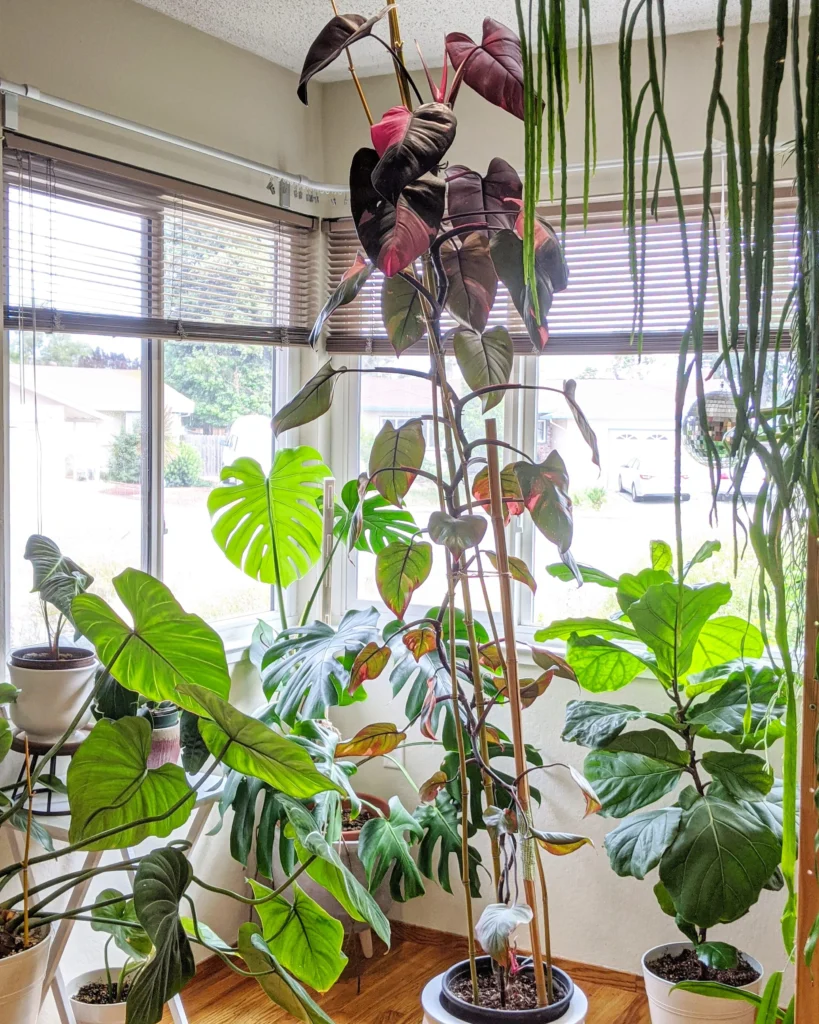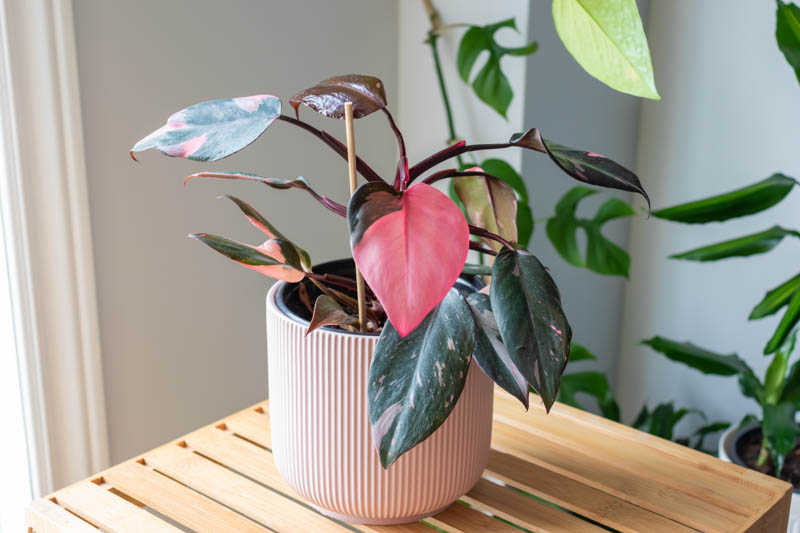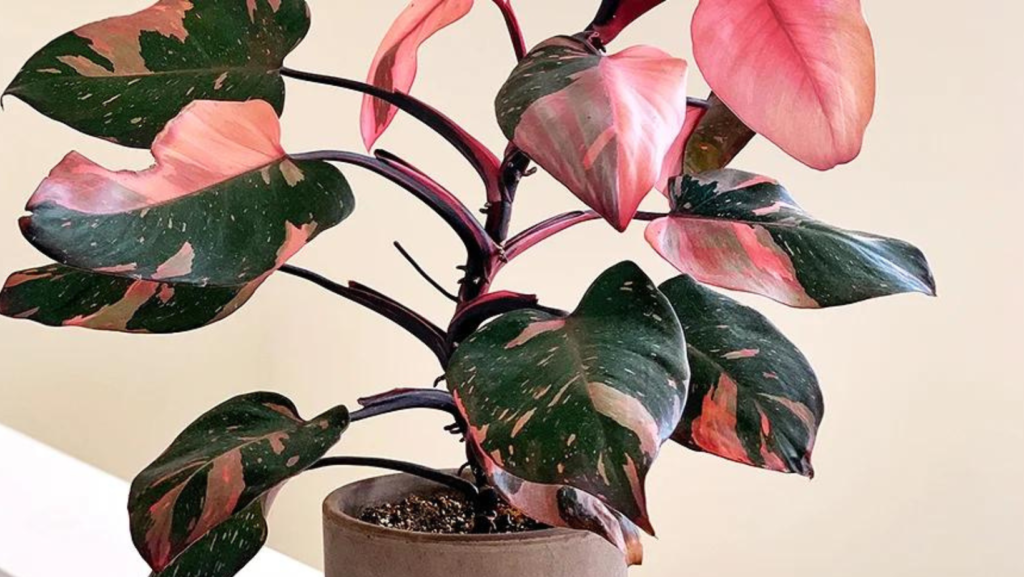There is an amazing variety of greenery available for indoor plants, but few are as heartwarming as the Pink Princess Philodendron. This fascinating cultivar has gained popularity among collectors and plant enthusiasts alike because of its striking pink variegation splashed across its deep green heart-shaped leaves. Unlike its near sibling, the Philodendron Pink Congo, whose artificial pink hue fades with time, the pink on a Pink Princess is a natural miracle, and its particular beauty is more than simply a temporary popularity.
The Pink Princess Philodendron has a very low maintenance requirement in addition to its captivating look. This tropical marvel doesn’t require continual care and may flourish in a range of lighting situations, unlike several other high-maintenance houseplants. Because of its versatility and gorgeous appearance, the Pink Princess Philodendron is a great option for both experienced plant parents and inquisitive novices. The Pink Princess Philodendron is guaranteed to inject your surroundings with a blast of life and vitality, whether you’re looking to add a flash of color or long for a hint of the tropics indoors.
Its laid-back demeanor betrays its South American heritage. Originating from a country with abundant rainforests, the Pink Princess Philodendron possesses a resilience that enables it to thrive in a range of conditions. Its beautiful, long vines with heart-shaped leaves can climb or cascade, converting any area into a private tropical haven with the right maintenance. Therefore, go no further than the Pink Princess Philodendron if you’re searching for a plant that combines both mesmerizing beauty and surprisingly manageable care. Let’s take a closer look and discover the keys to maintaining the health and vibrancy of this amazing plant, as well as the beautiful pink variegation, for many years to come.
RELATED BLOGS:
| Botanical Name | Philodendron erubescens ‘pink princess’ |
| Common Name | Philodendron pink princess, blushing philodendron |
| Family | Araceae |
| Plant Type | Perennial |
| Mature Size | 4-5 ft. tall, 2-4 ft. wide |
| Sun Exposure | Partial |
| Soil Type | Loamy, moist but well-draining |
| Soil pH | Acidic |
| Bloom Time | Spring, summer |
| Flower Color | Green, white |
| Hardiness Zones | 9a, 9b, 10a, 10b, 11a, 11b |
| Native Area | South America |
how to trim a pink princess philodendron
With its gorgeous variegated leaves, the Pink Princess Philodendron is a highly sought-after houseplant. But what if you could make more of these alluring climbers and multiply its beauty? Trimming, the process of growing new plants from ones you already have, holds the key to the solution. You will be guided through every step of the process by this guide, from choosing the ideal stem to seeing the birth of a new Pink Princess.

Choosing a Healthful Stem
Imagine a vivid Pink Princess with leaves that are a good balance of pink and green, growing in indirect sunshine. This is the best possible candidate to spread! This is the reason why:
Bright Color: A robust, deeply colored stem denotes a well-nourished plant that produces a sufficient amount of chlorophyll. The plant grows faster thanks to this chlorophyll, which increases the likelihood that it will effectively develop new roots and leaf during propagation.
Sturdy Leaves: Seek for sturdy, pristine foliage. Damaged, wilted, or yellowing leaves point to possible illness or stress. A cutting with more resources to dedicate to root development is a healthy leaf.
No Indices of Distress: Avoid picking any stems that exhibit symptoms of illness, infestation, or physical harm. These problems have the potential to weaken the plant and impair effective propagation.
Important Step: To avoid the transfer of any potential diseases to your parent plant or the new propagation, disinfect your pruning shears with rubbing alcohol before taking a cutting.
Cutting the Stem
After selecting the perfect stem, it’s time for the thrilling part: cutting! Here’s ways to make sure the split is tidy and healthful:
Sharp Shears: The formation of roots can be hampered by dull shears that crush and harm the stem. For an exact cut, use sterilized, sharp pruning shears.
Strength of the Node: The swelling lumps on the stem where roots and leaves originate are called nodes. On the stem of your choice, find a healthy node and cut a clean slice just below it. This arrangement promotes the node’s fresh root growth.
Removal of leaves (Optional): One mature leaf can be left on the cutting to start producing energy. To encourage root growth, some people would rather remove all lower leaves. You have the option!
Propagation Techniques
The alternatives are what make cultivating Pink Princess Philodendrons so beautiful! Depending on your comfort level and preference, you can plant directly in the soil or use water propagation.
Water Transmission
Easy Setup: All you need is some fresh, room-temperature water in a clean glass container.
Submerge the Node: Make sure that the remaining stem remains above the waterline, and that at least one, preferably two, nodes are immersed in the water.
Light and Site: Choose a spot where your container will receive bright, indirect sunshine. Steer clear of direct sunlight as it may damage the fragile stem.
The Key Is Patience: The growth of roots can take two to three weeks. Tiny white roots will start to emerge from the nodes. Your cutting is ready to be placed in soil once the roots are about one inch long.
Propagation of Soil
Pick a container that has drainage holes that are just a little bit bigger than the diameter of the piece you are cutting. Put in a potting mix that is aerated and well-draining and designed especially for aroid plants, such as philodendrons.
Planting the Slice: Make sure the stem is gently inserted into the little hole you dug in the potting mix, with at least one node buried beneath the soil’s surface.
Controlling Moisture: Make sure you fully hydrate the soil and leave any extra water to flow out of the drainage holes.
Humidity Haven: The success rate of the cutting can be greatly increased by creating a humid environment surrounding it. This can be accomplished by setting the pot on a pebble tray that has been filled with water or by loosely covering it with a clear plastic bag.
Selecting Your Approach: Pink Princess Philodendrons can be propagated with both soil and water. While some plant parents may find soil propagation more natural, water propagation makes it easier to observe the growth of the roots. Try different approaches to determine which one suits you the best!
how to properly care for a pink princess philodendron after trimming

Sustaining Humidity: A humid atmosphere is beneficial for the propagation of both water and soil, particularly in the early phases of root formation. Here are a few methods to make this happen:
A Pink Princess Philodendron needs to be properly cared for after cutting in order to maintain its health and vigor. Here are some essential actions to take:
Preserve Ideal Lighting: To encourage strong growth and vivid variegation, give your plant bright, indirect light. Steer clear of direct sunlight, especially in the afternoon and evening.
Watering Schedule: Let the soil’s upper portion dry out in between applications. When watering a plant, make sure it is not submerged in water to avoid root rot. Adapt the frequency of watering to the needs of the plant and the season.
Humidity Control: High humidity conditions are ideal for Pink Princess Philodendron growth. To raise the humidity levels, think about using a humidifier or putting a pebble tray with water in it close to the plant. This encourages healthy growth and lessens the chance of the leaves becoming brown.
Pebble Tray Magic: Set your propagation container or pot on a pebble tray that has water in it. A moist microclimate is produced around your cutting as the water vapor evaporates.
Fertilization: Throughout the growing season, give your plant a balanced houseplant fertilizer every four to six weeks. Since the plant is going into dormancy in the early fall, avoid fertilizing at this time. For accurate application, adhere to the directions on the fertilizer package.
Pest and Disease Monitoring: Keep a watch out for common pests such as spider mites, aphids, and mealybugs. Check the plant frequently for any indications of illness or pest infestation, and act quickly to address any that you find.
Pruning: Even if you have recently pruned your plant, it may still need occasional pruning to keep its form and promote new development. When necessary, cut away any yellow or damaged leaves with sterile scissors.
You can ensure that your Pink Princess Philodendron recovers quickly from trimming and keeps growing strong, displaying its gorgeous variegated foliage, by adhering to these maintenance instructions.
Transitioning to Soil (Water Propagation Only):
It’s time to move your cutting to soil once it has robust, one-inch-long roots. How to do it is as follows:
Set Up the Pot: Select a pot that is just a little bit bigger than the root system and has enough drainage holes. Put in some aerated, well-draining potting mix that is appropriate for aroid plants.
Does It Gently: Taking care not to damage the fragile roots, carefully take the cutting out of the water.
Planting Conscientiously: Make sure the cutting is buried at least one node below the surface of the soil by carefully placing it in a small hole dug out of the potting mix.
Watering and Cleaning Up: Make sure you fully hydrate the soil and let any extra water runoff. Maintain humidity levels, give plants the right amount of light, and water them according to the above-mentioned post-propagation care instructions.
what tools are needed to trim a pink princess philodendron
To trim a Pink Princess Philodendron, you will need the following tools:
- Sharp, Sterile Shears: Essential for making clean cuts to prevent infection and ensure successful propagation.
- Rooting Hormone (Optional): Consider using a rooting hormone to stimulate growth when propagating through stem cuttings.
- Pruning Shears or Scissors: Use these to cut the stem and separate your cuttings. Pruning is best done in the spring or fall, right before or after the growing season.
- Plastic Cover (Optional): Useful for creating a mini greenhouse effect to maintain humidity when propagating nodes.
- Disinfected Garden Shears: Always disinfect your cutting tools before and after each use to prevent introducing harmful pathogens to your plant.
what is the best time of year to trim a pink princess philodendron
The best time of year to trim a Pink Princess Philodendron is in the early spring or late fall, before or after the growing season.This timing allows the plant to recover and thrive after pruning, ensuring optimal growth and health.
what are some common pests or diseases that can affect a pink princess philodendron after trimming
Following pruning, a Pink Princess Philodendron may become infested with mealybugs, aphids, spider mites, scale, and fungus gnats.
If these pests are not removed right away, the plant’s look and health may be jeopardized. Furthermore, illnesses like rust spot, which is brought on by a fungal infection, and root rot, which frequently results from excessive watering, might affect the plant’s health after cutting.
Continual observation and prompt action are essential to stop extensive harm and preserve the health of the plant.


